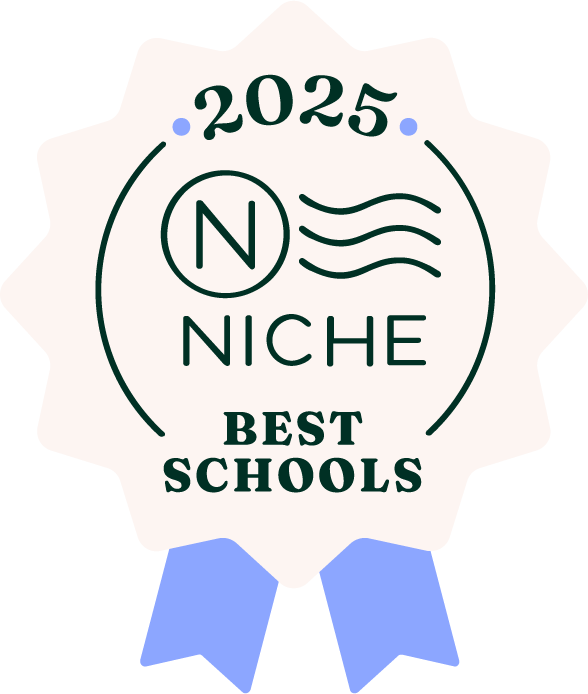You may have noticed an unusual orange fruit popping up everywhere on campus. You may even have asked, "what is that?"
Originally from Asia, and morphologically considered a berry, the persimmon is a lovely fruit that matures to a deep orange color in late Autumn. If you’ve ever visited Greensboro Montessori School's Primary Garden, you’ve probably noticed our beloved persimmon tree, planted over 20 years ago by master permaculturalist, Charlie Headington. In the years since, this tree has been lovingly pruned and harvested by our favorite garden coordinator, car line greeter, facilities assistant, and student support pal, Aubrey Cupit.
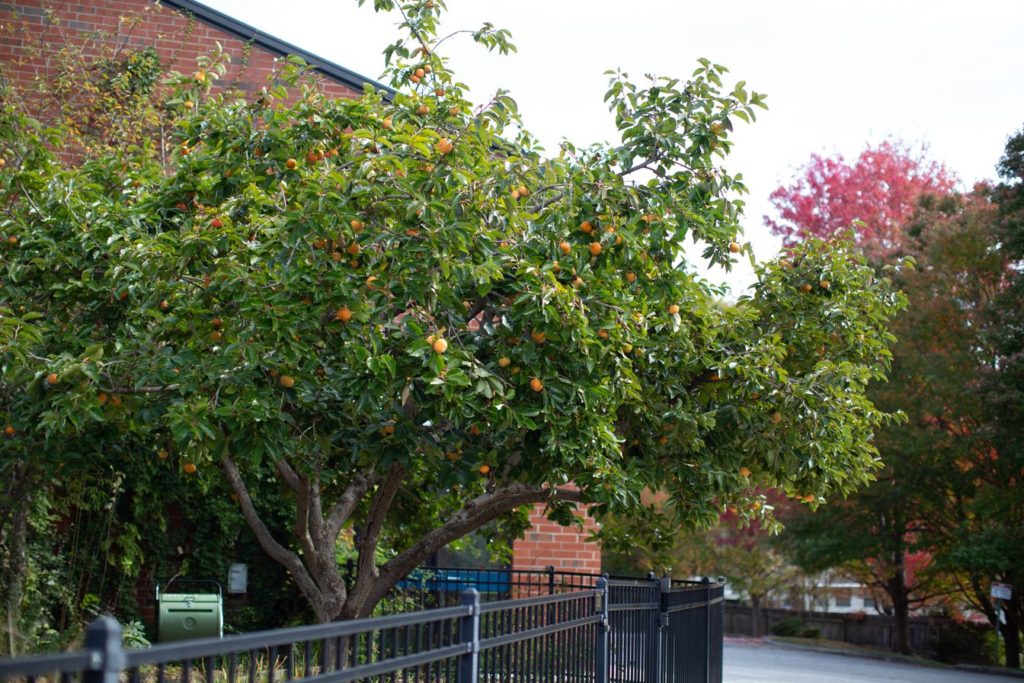
Generations of GMS students share a collective nostalgia for the flavor of the persimmon. To them, it seems a rare, exotic fruit with notes of magic and pure joy only attainable from our grounds. Students begin asking for persimmon snacks in our Environmental Education classes on the very first day of school, and then every subsequent day until we cut into the first ripe persimmon in October. It would be difficult to adequately describe the infectious wave of excitement when our students find out we are having persimmons for snack.
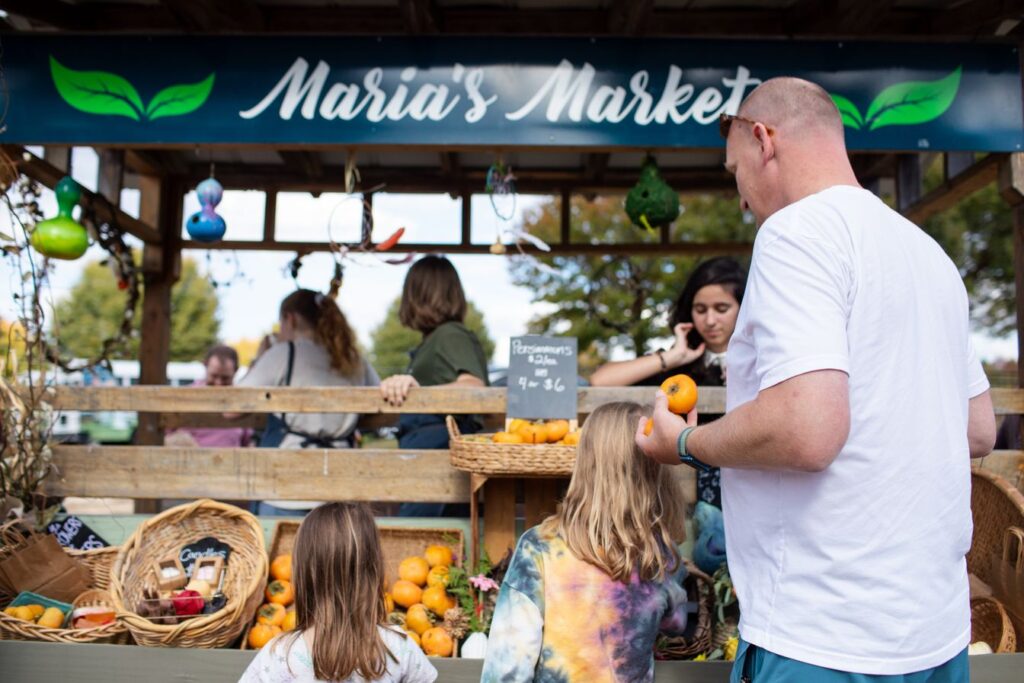
A firm persimmon tastes like a combination of honey, peach, and mango, with earthy undertones and the texture of an apple. For those unfamiliar with this fruit, I would recommend eating it raw, just like an apple, skin and all. Others prefer to bake softer persimmon pulp into pancakes, bread, or cookies. Persimmons work well in savory applications such as persimmon vinaigrette and other meat-based dishes akin to pork and apples. Dehydrated persimmon pulp creates a delicious fruit leather, while dehydrated persimmon slices make an excellent snack.
Each of the five persimmon trees on campus have produced bountiful fruit this season! Our students have reveled in their tastings during Environmental Education lessons and our Junior High Culinary Arts team has been baking with them voraciously! Word on the street is there's a tasty recipe for persimmon scones going around.
Additional Resources
- NPR: Ancient Japanese Food Craft Brings Persimmons To American Palates
- Martha Stewart: 13 Persimmon Recipes Everyone Should Make This Fall
- Wikipedia: Persimmon
Dr. Maria Montessori was a big fan of field trips. In her words, it was important for students to take “outings” or to “go out.” In 1948, Dr. Montessori wrote: “The outing whose aim is neither purely that of personal hygiene nor that of a practical order, but which makes an experience live, will make the child conscious of realities … When the child goes out, it is the world itself that offers itself to him. Let us take the child out to show him real things instead of making objects which represent ideas and closing them up in cupboards.” Hence, the Montessori phrase of “going out” was born.
At Greensboro Montessori School, we take the Montessori tradition of “going out” to heart, as our students take academically aligned, overnight field trips beginning in Lower Elementary. Where lessons in the classroom are a springboard to learning, Montessori outings provide the experiences necessary to move concepts from the abstract to the concrete – to let students apply and expand their knowledge in the world around them.
As our students progress from Toddler to Junior High, they learn the rites of passage, including the field trips, which will greet them along the way. Read about all our adventures, or jump to the division that interests you most!
Lower Elementary
Beginning in second grade, Lower Elementary students take annual trips to either Earthshine Discovery Center in the Nantahala National Forest in western North Carolina or the Sound to Sea program along the North Carolina’s Crystal Coast. Second and third grade students spend two days and three nights building upon their lessons in biology, botany, environmental studies, geography, history, and physical science.
Upper Elementary
North Carolina's Outer Banks: Fourth graders travel to North Carolina’s Outer Banks where they experience the region’s rich marine biology and storied history. Students visit national landmarks like Roanoke Island, the first settlement of English colonists, and the Wright Brothers National Memorial in Kitty Hawk. In the words of the National Parks Service, Kitty Hawk is the site where Wilbur and Orville Wright “experimented with flight in the early 1900s, and finally succeed[ed] on a cold winter day with the world's first controlled, sustained, powered, heavier-than-air flight.”
Colonial Williamsburg: Fifth graders travel to Colonial Williamsburg, where they immerse themselves in the history of the American Revolution and explore, as Colonial Williamsburg puts it, “the political, cultural, and educational center of what was then the largest, most populous, and most influential of the American colonies. It was here that the fundamental concepts of our republic — responsible leadership, a sense of public service, self-government, and individual liberty — were nurtured under the leadership of patriots such as George Washington, Thomas Jefferson, George Mason, and Peyton Randolph.”
Due to class sizes and travel logistics, fifth and sixth graders will travel together this year, heading to Washington, D.C. Next year, our current fifth graders will enjoy their Williamsburg experience as sixth graders.
Washington, D.C.: Sixth-grade students head to our nation’s capital, where they visit multiple Smithsonian museums, (including the National Museum of African American History and Culture and the National Air and Space Museum), the National Archives, Arlington National Cemetery, and the National Gallery of Art and Sculpture Garden. Students expand upon their knowledge of national government and civics, while practicing grace and courtesy in a metropolitan city center. Dr. Montessori writes: “A child enclosed within limits however vast remains incapable of realizing his full value and will not succeed in adapting himself to the outer world. For him to progress rapidly, his practical and social lives must be intimately blended with his cultural environment.”
Junior High
Seventh and eighth graders rotate between annual field trips to Arizona and Costa Rica every spring.
Arizona: When students head west to Tuscon, Arizona, their years of environmental science studies take center stage during a week-long trip. In addition to hiking Kitt Peak, students spend time at the University of Arizona’s Biosphere 2, a state-of-the-art scientific facility. The mission of Biosphere 2 “is to serve as a center for research, outreach, teaching and life-long learning about Earth, its living systems, and its place in the universe; to catalyze interdisciplinary thinking and understanding about Earth and its future; to be an adaptive tool for Earth education and outreach to industry, government, and the public; and to distill issues related to Earth systems planning and management for use by policymakers, students and the public.”
Costa Rica: When students make their way to San José, Costa Rica, they enjoy an authentic immersion experience that includes living with the Costa Rican families of students from The Summit School, our sister school in Coronado, Costa Rica. Together, our students and the Ticos (a colloquial term for natives of Costa Rica) go everywhere together. They visit volcanoes, complete high ropes courses, and sail through the rainforest canopy on zip lines. They travel to the Caribbean Coast where they walk the beach at night looking for turtle eggs to bury in a nearby protected hatchery. Then, they travel to the Pacific side to snorkel and explore rain forests and animal sanctuaries. They also spend a day in downtown San José learning about Costa Rican history, art, and government. With every visit to Costa Rica, our students return with their eyes a little wider and their lives a little richer as they have their first experience actually living in another culture.
Self-Directed Travel for Ninth Graders: An important element of our ninth-grade curriculum is the completion of a year-long capstone project that challenges each student to apply their skills to an area of personal interest that will improve and enhance their world. Similar to a thesis or senior project, the capstone project provides a framework for demonstrating leadership and advanced application of critical thinking skills. To further extend their learning, the students are challenged to design a custom end-of-year outing to include research opportunities for each of their individual capstone projects. In collaboration with a faculty advisor, a past ninth grade class settled on an itinerary traveling throughout the Pacific Northwest. Their route took them to explore tidal pools, tour museums in Seattle, visit a military base in Tacoma, and interview refugees in Vancouver.
Greensboro Montessori School's Upper School students took a leading role in Friday's Earth Day celebration. Upper Elementary students kicked off the morning with readings of original poetry and Spanish. After the program (which we shared live on Facebook), Junior High students hosted Lower and Upper Elementary students at eight different different stations set up on the Athletic Field. Each station featured an activity to to raise awareness for Earth Day, including ideas for recycling, composting, and even limiting our waste. Primary students enjoyed a lesson with our environmental educators, Chelsi Crawford and Sara Stratton. Toddler students took everything in from their shaded mats under the trees, just steps away from their play yards.
The original poetry shared by our Upper Elementary students highlights our integrated curriculum. Students combine their skills in English, Spanish, creative writing, science, environmental education, public speaking, and leadership all at once. We are honored to publish their work for all to experience.
Redbud Tree
Lydia, Sixth Grade
The Eastern redbud tree, purple blossoms in early spring. Small beacons of colour adorn the dull, monochromatic landscape. Bursts that spring is just around the corner.
As the blossoms begin to fade, they get swept away by the gusts of wind that spring brings. Petite purple petals pressed onto the ground as they get trampled by tiny feet. But not all is lost, leaves that are a deep crimson, like garnet, or a sharp, zesty lime the size of a hand unfurl. The leaves are shaped like spades. Desperately trying to hold onto their branches by their paper-thin stems. Through treacherous storms they hold on, not falling yet, for the leaves have roots of their own.
The redbud tree is eternally stretching, reaching its roots through the mycelium and soil, while the branches are competing for the warm rays of sunlight. The uneasy cottontail rests by the roots of the tree, protected by the lush canopy from the hungry hawks’ view.
During autumn, the leaves of the redbud tree glow orange, like a campfire. Only turning into a bonfire as the chorus of the other deciduous trees chime in in the early November. Then, the redbud tree goes to sleep as the long, cold winter days begin.
Día de la Tierra Upper Elementary Group A
- Debemos cuidar la Tierra porque es el único planeta que temenos.
- Debemos cuidar la Tierra porque es nuestra casa y nuestro hogar.
- Debemos cuidar la Tierra porque vivimos en ella.
- Debemos cuidar la Tierra porque hay animales, árboles, océanos y más.
- Debemos cuidar la Tierra porque es la casa para todos los tipos de vidas.
- Debemos cuidar la Tierra porque nos da comida.
- Debemos cuidar la Tierra porque es la casa de todos.
- Debemos cuidar la Tierra porque es muy bonita. Los humanos debemos comprender que no se debe hacer daño a la Tierra.
- Debemos cuidar la Tierra porque o si no nos extinguieremos.
- Debemos cuidar la tierra porque es nuestra protectora y nuestro hogar.
sphagnum
Tanner, Fourth Grade
The sphagnums dance in the rain like an umbrella being twirled. The sphagnums dance in the rain on the mother tree. The sphagnums dance in the rain in the rainforest. The sphagnums dance in the rain under the shade. The sphagnums dance in the rain and the damp mother tree is playing her music. The sphagnums dance in the rain, their spore capsules open up and the spores fly away. The sphagnums dance in the rain as the 10,000 ancestors watch them. The sphagnum dances in the rain, the calm green color is shimmering on as the rain falls on them, the sphagnums dance in the rain; they have no roots, stems, leaves or seeds. The sphagnums dance in the rain, they can grow until they run out of room. The sphagnums dance in the rain in their fuzzy soft coats. The sphagnums dance in the rain. They are used for medicine to save peoples lives. The sphagnums dance in the rain; they get picked and re-planted to make a garden look nicer. The sphagnums dance in the rain.
Greensboro Montessori School's Junior High students just culminated one of their project based learning assignments – hatching, growing, and releasing brown trout.
Junior High science teacher, Tim Goetz, released the trout in a cold water tributary of the Smith River near Bassett, Virginia. It was a Friday morning in the middle of the COVID-19 pandemic. Normally, our Junior High students would have been stream-side with Tim, and it would have been their job — not their teacher's — to complete the final step of their semester-long project. Instead, students joined Tim virtually to watch the trout meet their natural habitat.
As the trout grow, they will make their way up river into the Smith River. Along the way, they will eat land and water insects, zooplankton, worms and other aquatic creatures. They will also search for hiding places from predators, including birds and other fish. Tim Key, a member of the Nat Green Fly Fishers Club, who was present at the release said "these are some of the best fish I have every seen."
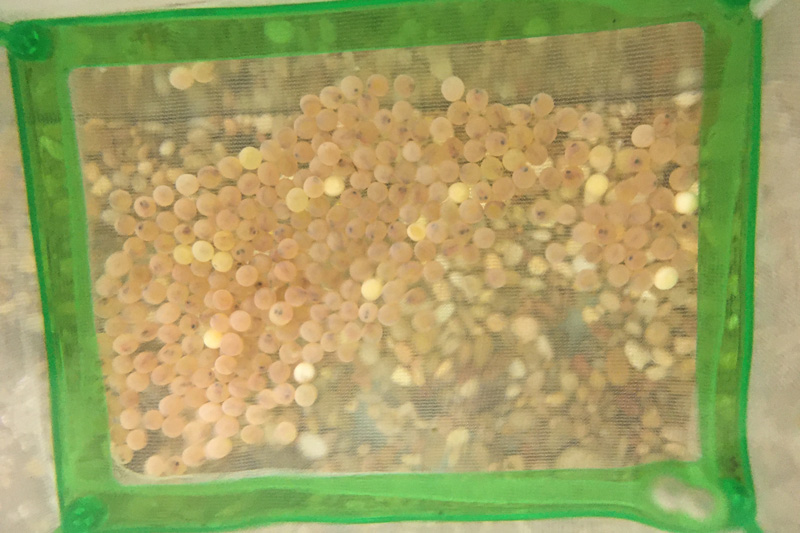 The fish were hatched at Greensboro Montessori School as a part of the nationwide Trout in the Classroom program, with support from the Dan River Basin Association, and Tim Key of the Nat Greene Fly Fishers Club. Over 250 eggs were given to the School on December 5, 2019 and the first hatch was December 10.
The fish were hatched at Greensboro Montessori School as a part of the nationwide Trout in the Classroom program, with support from the Dan River Basin Association, and Tim Key of the Nat Greene Fly Fishers Club. Over 250 eggs were given to the School on December 5, 2019 and the first hatch was December 10.
The fish were raised in a 45-gallon, cold-water aquarium at 50 degrees Fahrenheit in Greensboro Montessori's Upper School. To quickly prepare the correct growing environment, students mixed five gallons of water from the School's pond with 40 gallons of tap water. Students tended to the fish daily, including feeding, changing water, and water testing. Daily water tests included pH, ammonia, and nitrites with the goal of recreating a natural, cold-water trout habitat. This attention to detail resulted in the science room smelling more like an outdoor classroom next to a river than a traditional classroom.
Eighth grade student, Nina, was the head aquarium tender and her classmate, Ava, provided the backdrop art for the aquarium.
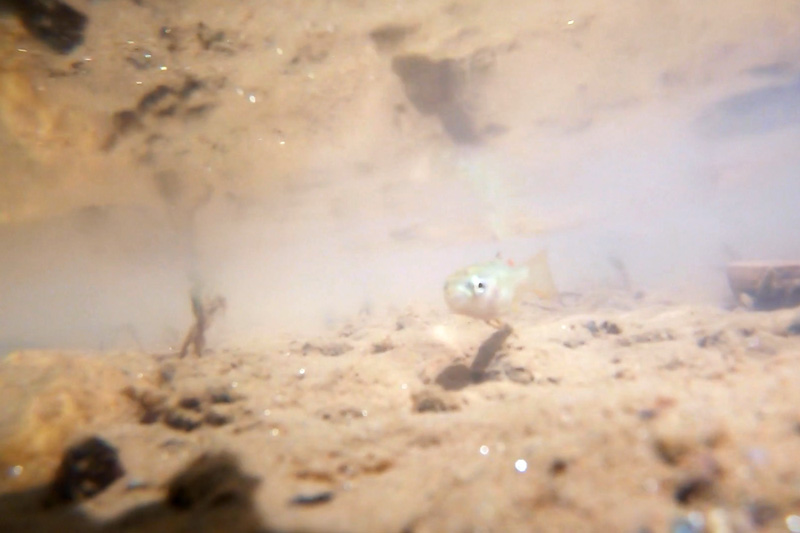 Prior to COVID-19, Junior High students were scheduled to travel to Virginia to release the trout themselves. Their expedition would have been part of their April Land Week, one of several weeks a year when they learn at Greensboro Montessori School's 37-acre satellite campus in Oak Ridge, N.C. With schools throughout the state suspending in-person learning, the students' land week and field trip was cancelled, but not their learning. Students participated in the trout release through a Live Lesson via Google Hangouts. Tim also documented the release on GoPro cameras so he could share the experience with the entire school community, Toddler through Junior High. After all, Greensboro Montessori School students learn everywhere, whether its the indoor, outdoor, or virtual classroom.
Prior to COVID-19, Junior High students were scheduled to travel to Virginia to release the trout themselves. Their expedition would have been part of their April Land Week, one of several weeks a year when they learn at Greensboro Montessori School's 37-acre satellite campus in Oak Ridge, N.C. With schools throughout the state suspending in-person learning, the students' land week and field trip was cancelled, but not their learning. Students participated in the trout release through a Live Lesson via Google Hangouts. Tim also documented the release on GoPro cameras so he could share the experience with the entire school community, Toddler through Junior High. After all, Greensboro Montessori School students learn everywhere, whether its the indoor, outdoor, or virtual classroom.
Learning through purpose-filled, project-based learning — like hatching, raising, and releasing brown trout into their natural habitat — is not the exception to the rule at Greensboro Montessori School. It is the rule. Our students learn through completing meaningful work, which often results in real-world benefits to the community. Through the multistep process of researching, designing, implementing, refining, analyzing, and presenting their projects, our students gain real-world skills such as resiliency, creativity, curiosity, time management, and public speaking. They also develop a sense of self-worth by understanding the value of their contributions to society and experiencing personal fulfillment.
Click here to read about about another real-world project our Junior High students are leading: inoculating, growing, harvesting, and selling shiitake mushrooms.
In addition to Trout in the Classroom, Dan River Basin Association, and Nat Greene Fly Fishers Club, Greensboro Montessori School would like to thank Oliver Rouch from K2 Productions for lending us GoPro cameras and editing our release footage. We also want to thank Tim Key for his work behind the camera.
My very first year at Greensboro Montessori School, I worked alongside a wise and wonderful teacher, who is also my Montessori mentor. As our year together progressed into late spring, she suggested we teach a unit on the life cycle of the monarch butterfly and sent me afield to pick up a caterpillar tent from a local butterfly farm. It was a curious-looking contraption: a flowering milkweed plant with a gauzy covering. A week into our journey with this kit, my mentor had a family emergency that took her on an unexpected trip overseas ... for four weeks. At a moment’s notice, I found myself entrusted with the care of 12 children; one gerbil (my mentor knew I didn’t do rodents); a ragtag tray of fava beans sprouting in paper cups; and this milkweed plant, the presumed setting for the miracle of metamorphosis. That is, if I could keep it alive. It didn’t take long for me to realize that with this lowly plant came some extraordinary lessons in faith, respect, awe, tenderness, and trust.
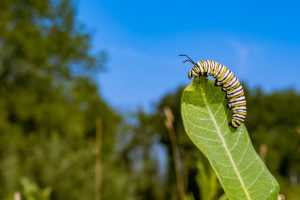 For those uninitiated in the art art of raising caterpillars: they take a while to become visible. A long while. Though we’d been promised that our plant came with a pair of Monarch eggs, those first two weeks rolled by with nary a sighting of the little beasts. Every day we checked for them, and every day I saw the skepticism grow in my students' eyes as I described the wondrous sight we were going to behold. Probably. Eventually. The morning we finally noticed wormholes in the leaves — evidence that our charges were indeed hatched and hungry — felt like waking up to breakfast in bed on your birthday.
For those uninitiated in the art art of raising caterpillars: they take a while to become visible. A long while. Though we’d been promised that our plant came with a pair of Monarch eggs, those first two weeks rolled by with nary a sighting of the little beasts. Every day we checked for them, and every day I saw the skepticism grow in my students' eyes as I described the wondrous sight we were going to behold. Probably. Eventually. The morning we finally noticed wormholes in the leaves — evidence that our charges were indeed hatched and hungry — felt like waking up to breakfast in bed on your birthday.
Once our caterpillars became visible, they grew at a blazing speed, delighting the toddlers with their impossibly lovely stripes and ravenous eating habits. The students relished the idea that these creatures never, ever accepted any food but milkweed. “Wouldn’t you like some pizza, dears?,” I’d ask the worms. “Maybe a nice cup of coffee?” The children would squeal, “NO WAY!,” perhaps reminded of their own choosy appetites. An assortment of suggested names were bandied about, ranging from Lexy to Tiger to Dobo to Burp. (The caterpillars didn’t seem to have a preference.)
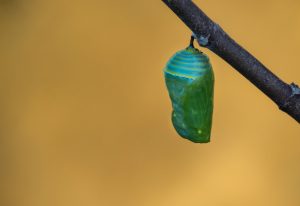 One sunny morning, we found the caterpillars hanging from the leaves in their mysterious “J” formation, the behavior that immediately precedes the formation of the chrysalis. Within hours, they were caterpillars no more. If I had not seen it with my own eyes, I could never have imagined the reverence and care the students extended once this transformation had taken place. They seemed to instinctively know their tiny pets now needed silence and space. Each morning, the toddlers took turns standing guard by the milkweed plant, gazing solemnly at the astonishing beauty of the chrysalises, misting them gently with a spray bottle. Many days of inaction followed ... yet, having awaited their friends’ first emergence, the students now had unwavering patience and faith. Some miracles, they’d learned, are worth waiting for.
One sunny morning, we found the caterpillars hanging from the leaves in their mysterious “J” formation, the behavior that immediately precedes the formation of the chrysalis. Within hours, they were caterpillars no more. If I had not seen it with my own eyes, I could never have imagined the reverence and care the students extended once this transformation had taken place. They seemed to instinctively know their tiny pets now needed silence and space. Each morning, the toddlers took turns standing guard by the milkweed plant, gazing solemnly at the astonishing beauty of the chrysalises, misting them gently with a spray bottle. Many days of inaction followed ... yet, having awaited their friends’ first emergence, the students now had unwavering patience and faith. Some miracles, they’d learned, are worth waiting for.
When the butterflies emerged during the last week of school, we carried them to the playground and prepared to set them free. Before they departed, they allowed each and every toddler to hold them awhile and sing them a send-off song (the choice was painfully obvious: “Let it Go”). When the monarchs finally took to the sky and fluttered toward the Primary garden, I knew the students and I were feeling the exact same mix of elation and heartache. After all, many of our toddlers themselves would soon be flying to the other side of the playground fence, away from the nest of our classroom and our many loving days together.
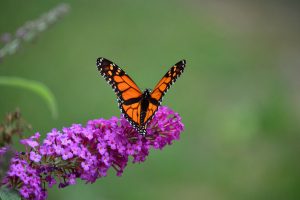 Six years later, having raised monarchs with every single toddler class I’ve taught since that first year, it’s time for my own metamorphosis. I am so excited for the new challenges and relationships that await me as I transition into the director of CASA role at Greensboro Montessori School. Yet there’s something about teaching that simply can’t be matched by any other profession. Year after year, I’ve witnessed the beautiful metaphor of little children caring tenderly for the tiny, fragile caterpillars whose lives begin in our classroom. I hope that’s in small part because they, too, have felt tenderly cared for here; that they understand the reverence and awe a teacher experiences as they watch their students grow, and the bittersweet pride they feel when it’s time to set their students free.
Six years later, having raised monarchs with every single toddler class I’ve taught since that first year, it’s time for my own metamorphosis. I am so excited for the new challenges and relationships that await me as I transition into the director of CASA role at Greensboro Montessori School. Yet there’s something about teaching that simply can’t be matched by any other profession. Year after year, I’ve witnessed the beautiful metaphor of little children caring tenderly for the tiny, fragile caterpillars whose lives begin in our classroom. I hope that’s in small part because they, too, have felt tenderly cared for here; that they understand the reverence and awe a teacher experiences as they watch their students grow, and the bittersweet pride they feel when it’s time to set their students free.
This year, when our current crop of monarchs depart for the great big world outside, we’ll all be ready to spread our wings and join them, together, in flight.
 About the Author
About the Author
Brooke Juneau joined Greensboro Montessori School's Toddler faculty in 2013. She holds her Infant & Toddler (bith to 3 years old) Montessori teaching credential and graduated from Hampshire College with a Bachelor of Arts in education and human development. Brooke is the mother of three boys. Her middle son, Hayden, graduated from Greensboro Montessori School in 2017. Brooke plays the guitar and loves singing with her students. Beginning in the 2019-20 school year, Brooke will be the School's director of CASA.
“Turn it, and turn it, and turn it, and turn it, and turn it, and turn it, Compost Cake!”
“Pile it high, pile it high, pile it high, Compost Cake!”
If you’ve heard this song about compost all around campus this fall and winter, it’s because we got new compost bins in the Primary and Lower Elementary gardens! Why did we get new bins, you might ask? Two reasons:
- We needed more space for the volume of organic waste we produce (a combination of garden waste and food scraps from the students' lunches and snack preparation)
- We wanted to try a more interactive, faster, and developmentally appropriate compost model for our younger students.
So what did we get? If you visit the Primary and Lower Elementary gardens, you’ll see some giant green cylinders sitting on a rotating axis. These compost bins are called tumblers. Tumbler compost models allow students of all ages to spin the compost (working those gross motor skills), in addition to speeding up the composting process. In our old bins, it took at least a year for our food waste and garden scraps to decompose fully, we'll make finished compost in as little as two weeks. Cheers to that!
What is Compost?
Compost is the product that’s left after organic matter has fully decomposed. It’s also called humus. Human-made compost comes from carefully mixing food and garden waste materials — ingredients high in either nitrogen or carbon — and placing them in an environment where they can decay. When the decaying process has gone well, we put the finished compost, or humus, back into the garden soil and grow healthier plants by improving soil fertility.
Why do we compost at Greensboro Montessori School?
For starters, compost has a longer ground-life than other fertilizers. It lasts longer in soil than crop residues or animal manures that degrade rapidly here in the humid Southeast. This longevity makes for healthier plants and food crops. Composting also reduces our waste throughout campus. By diverting organic matter from the landfill and into a closed-loop cycle, we transform our “waste” into a fertilizer for our gardens and food for the microorganisms that live in the soil beneath us. We also save money by eliminating the need and associated cost of additional soil fertility inputs. And let's not forget, composting is just plain fun!
Can you think of any other reasons to compost? Maybe, that by doing it, we are feeding the worms our Toddlers so adore? That it’s a responsible use of resources? That it's a project-based way to teach science? Share your thoughts with us! And, if you want to learn more, please join us at our next Community Garden Workday for more composting tips and tricks with our environmental education faculty. We’d love to have you.
If you're interested in learning more about the science of composting, read this article from Live Science.
 About the Author
About the Author
Eliza Hudson is Greensboro Montessori School's lead environmental educator. Eliza holds her bachelor's degree in biology from Earlham College in Richmond, Ind. She has built and tended school gardens, taught hands-on cooking lessons and connected local farms to school programs working for FoodCorps. Prior to joining Greensboro Montessori School in 2014, Eliza was a classroom and after-school assistant at the Richmond Friends School, a farm intern at a family-owned farm in Ohio, and served as assistant director at a summer day camp in an urban community garden in Durham.
Greensboro Montessori School has taught environmental education since 1995 and has been permaculture gardening on its campus since 1997.
Within the three-year cycle of Lower Elementary (first through third grades), students and teachers spend one year studying the fundamental needs of humans. This theme is woven throughout their curriculum and students embark on relevant research projects providing purpose and context for their learning. Over the year, the students learn why food, water, shelter, clothing, art, and community are necessary for humanity and how these needs have remained consistent throughout our time on Earth.
One of the ways our students share their growing knowledge of human civilization, and our most basic needs, is through their Festival of Light presentation. Students read the book “Celebrations Of Light : A Year of Holidays Around the World” by Nancy Luenn. The book is a springboard to research projects centered on 12 countries and the light-themed cultural celebrations that both define and unite them. It provides exposure to the diversity of our world while simultaneously highlighting how light brings people together.
Students form teams, each taking one of the 12 countries and its respective celebration. From there, they delve into the history of the country, its culture, and the celebration. They study some of their nation’s accomplishments, art, food, geography, religion, storytelling, traditions, and writings. All of this research prepares them to participate in Greensboro Montessori School’s triennial Festival of Light.
The Festival of Light features all of our Lower Elementary students in an evening presentation for their families, faculty, and members of the greater school community. Each of the 12 teams prepares a narrative on their country’s celebration of light. The celebrations include:
- New Year's Eve in Brazil
- The Chinese New Year
- The Lantern Parade (Eid al-Fitr) in Sierra Leone
- Lichtmesdag in Luxembourg
- Buddha's birthday in Korea
- Bon Matsuri in Japan
- Diwali in India
- Loy Krathong in Thailand
- Hanukkah in Israel
- Luciadagen in Sweden
- Christmas in the United States
- Las Posadas in Mexico
- Kwanzaa in the United States
The presentation itself anchors our students’ research in purpose and provides these first, second, and third graders with a nurturing and challenging academic experience. Surrounded by their families, friends, and teachers, students share their knowledge in a safe space where they will be celebrated for their work. The Festival of Light also challenges our students by pushing them to develop and expand their public speaking and presentation skills in new ways.
When the last celebration has been presented, the audience chairs have been put away, and the families have left for home, there’s no doubt our students have been part of an educational experience. One that has taught them about the fundamental needs of humans, community, teamwork, and so much more.
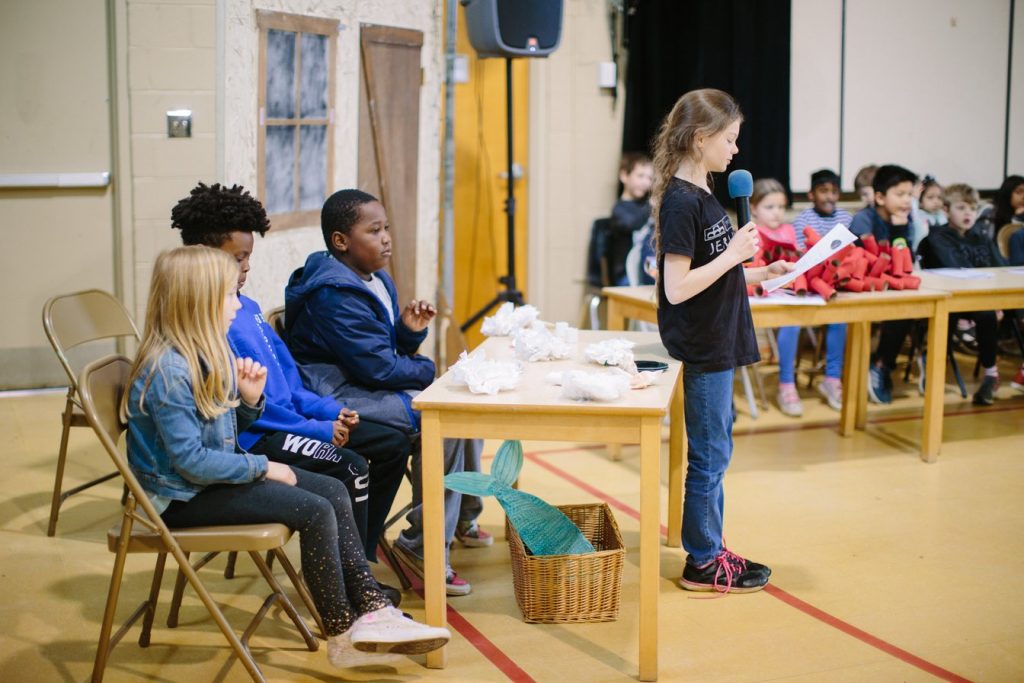
Lower Elementary students rehearse for Greensboro Montessori School's triennial Festival of Light.

Students reenact the Candlemas tradition of going door to door singing for a candy treat.
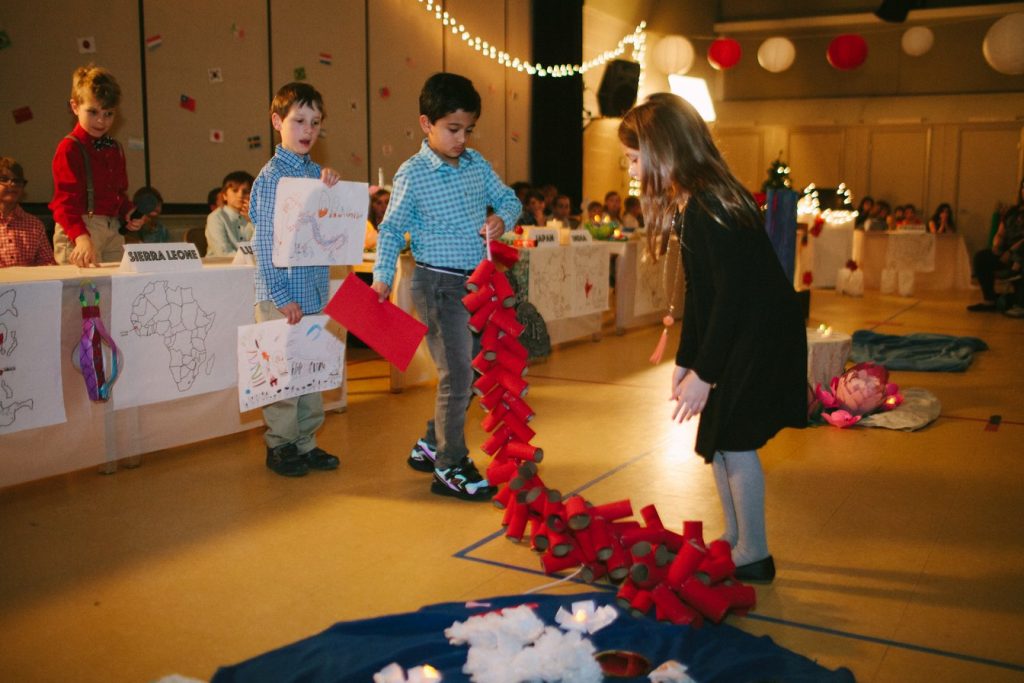
Students present the Chinese New Year, which is celebrated in China and Taiwan.
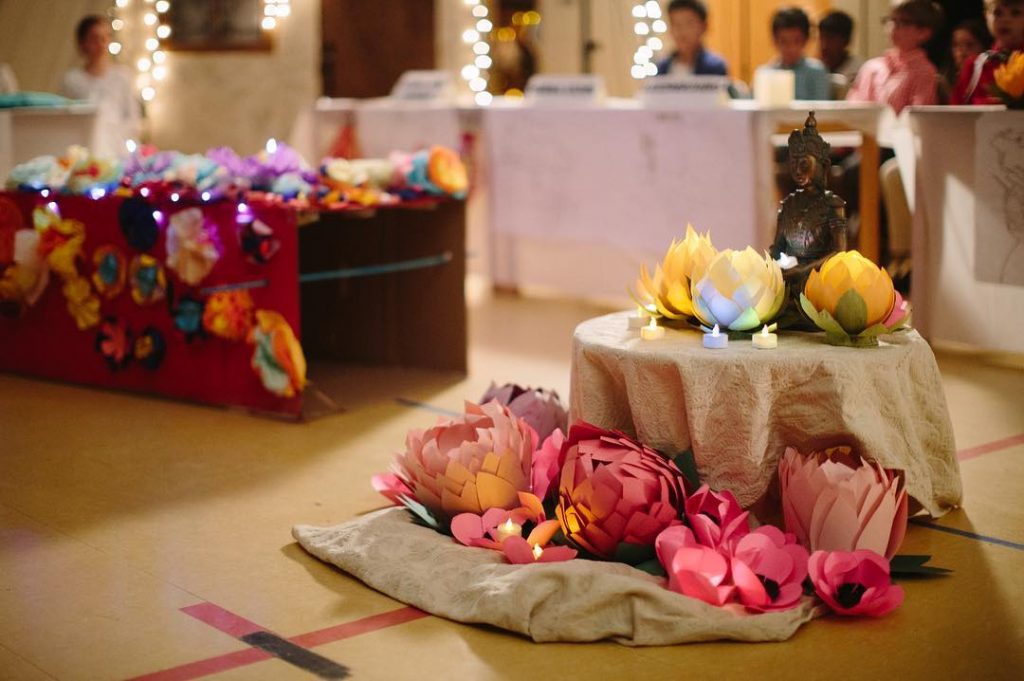
Pictured to the left is a student-made float for the Lantern Parade celebrating Eid al-Fitr in Sierra Leone. The celebration of Buddha's birthday in Korea is pictured to the right.

Here are the faculty, off to the side, letting the students take the lead in presenting their student research.
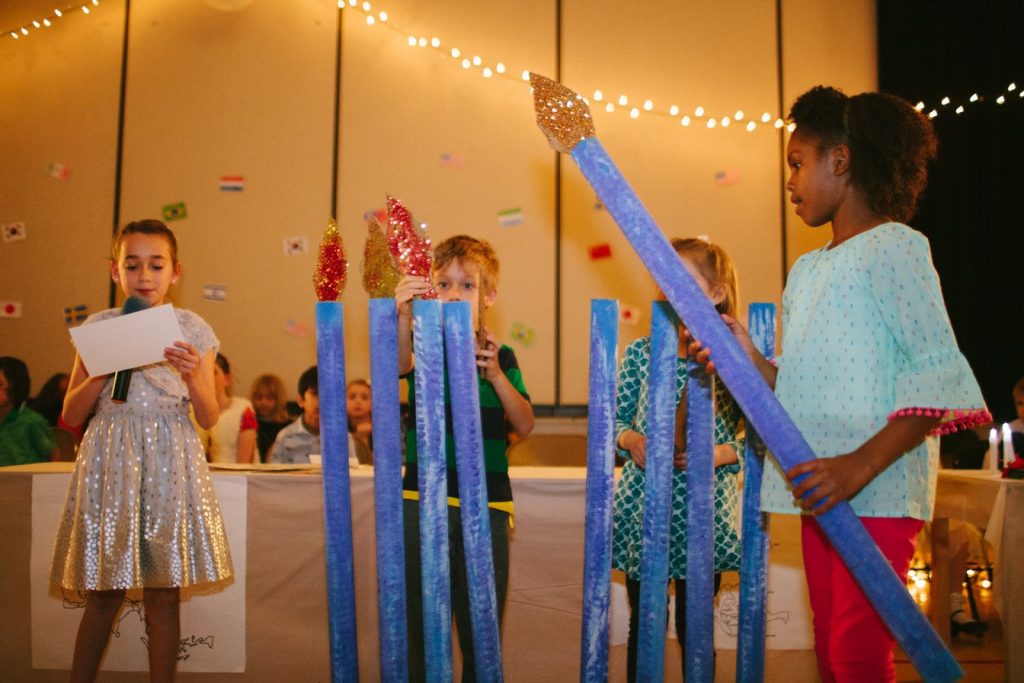
Students present the menorah and the lighting of the candles for Hanukkah in Israel.
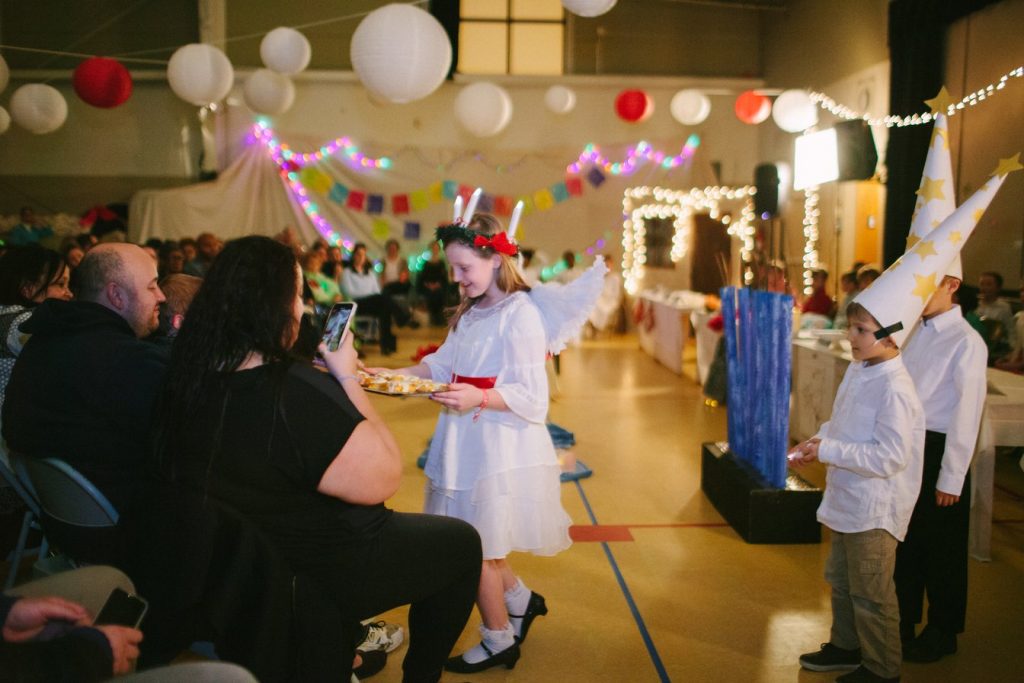
Luciadagen, or Lucia's Day, in Sweden, involves children dressing in all white and leading a procession while also handing out saffron buns.
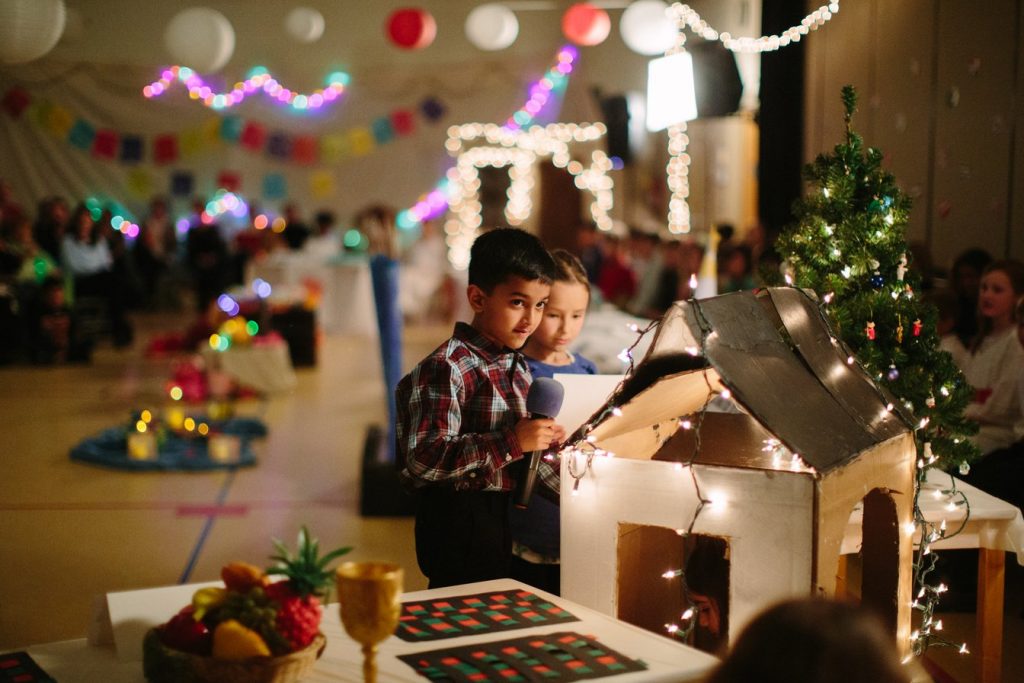
Las Posadas is a Christmas tradition from Mexico and is a reenactment of Mary and Joseph's search for the inn ("la posada") on Christmas Eve.
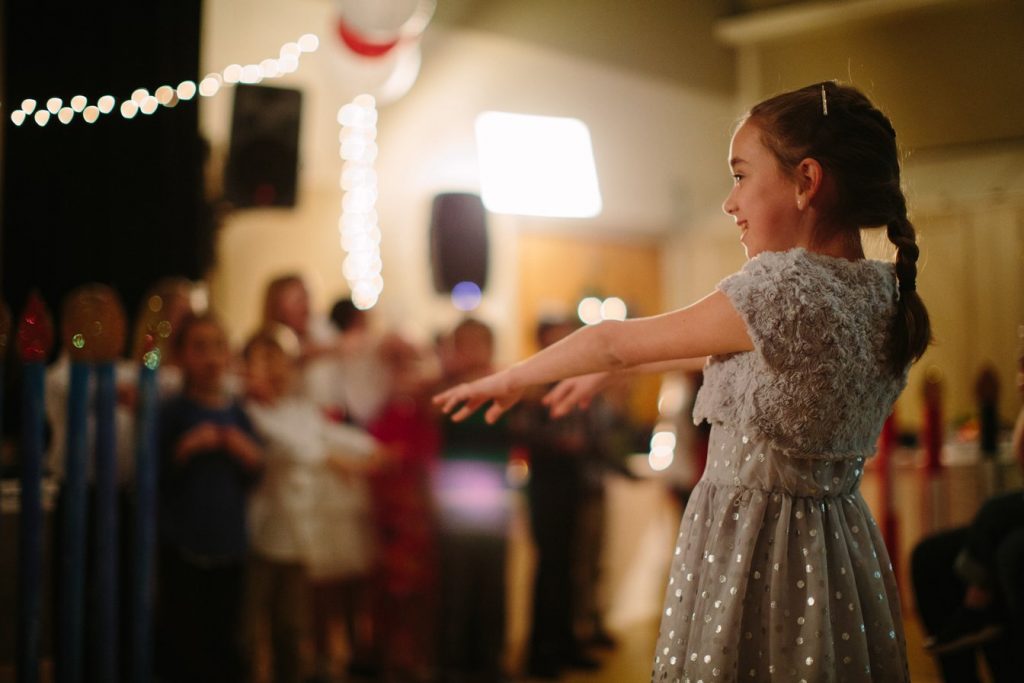
A third-grade student leads her peers in the final presentation of the night, a secular version of the song "This Little Light of Mine."
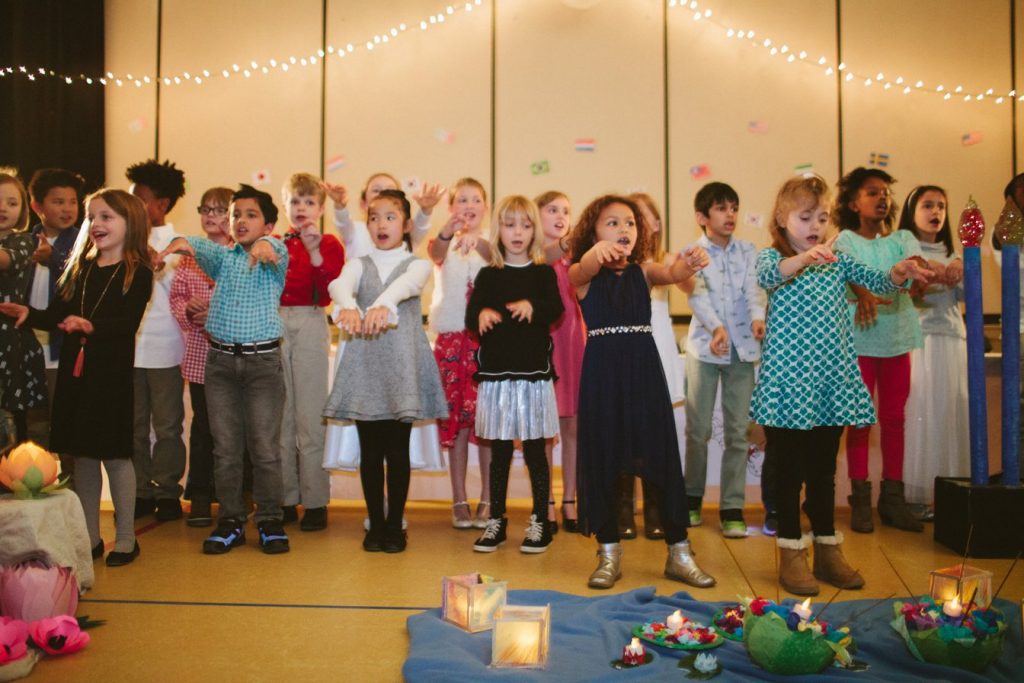
Students close their presentation by singing a secular version of "This Little Light of Mine."
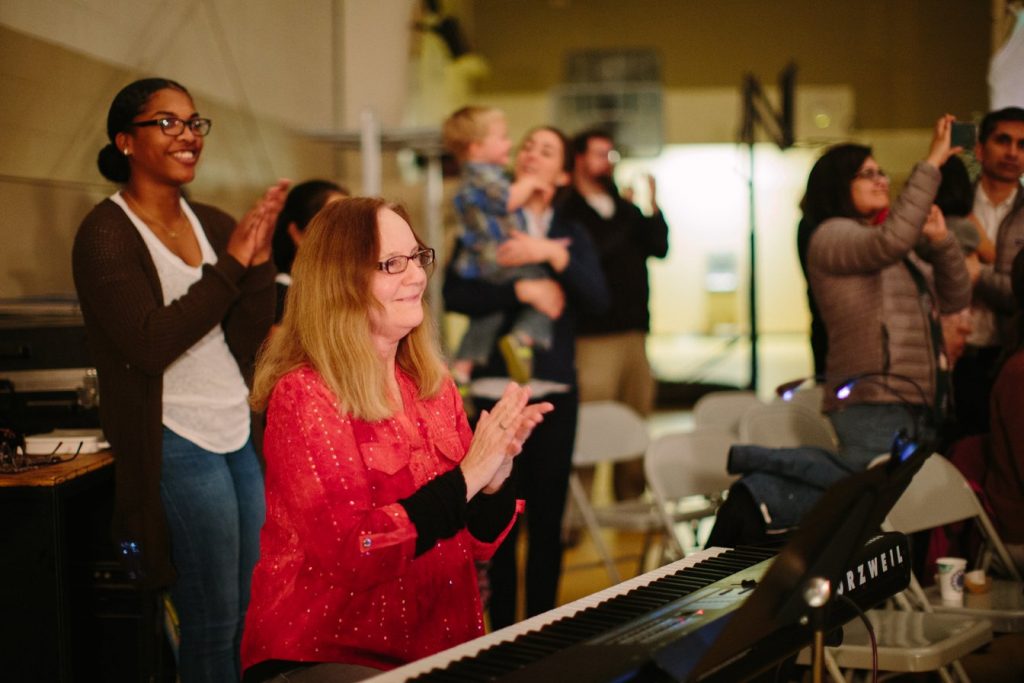
The Festival of Light comes to an end, and the students enjoy tremendous applause from the audience.
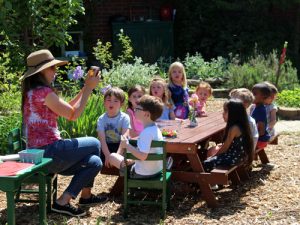
Sara Stratton leads Primary students in making dressing for their strawberry spinach salads.
Springtime is always joyful in Greensboro Montessori School's organic gardens. Winter buds swell and burst, capturing the eyes and hearts of community members, no matter their age! Flowers of all kinds call to us and to our pollinator friends, and sooner than we realize, we reach the height of the season.
This year brought a colder and wetter forecast than in the past. We’ve still yet to harvest our first sugar snap peas, but the strawberries and spinach are out with a vengeance! We continue to enjoy the lushness all the early rain and cool weather brought, even as temperatures rise. Here’s a brief update from our spring adventures!
Primary and Lower Elementary have enjoyed plenty of weeding, watering, planting, and tasting. We just finished a week full of strawberry spinach salads, with a bit of fennel and spring onions thrown in for fun! (Check out the recipe below if you’re interested in trying this at home.) In Upper Elementary, we celebrated the conclusion of our Student Climate Change Summit art exhibition with a persimmon-ginger-honey ice-cream party! Everyone agreed it was fun to make and even better to taste!
Thanks to everyone who attended our Spring Community Garden Workday in the Primary Garden. Together, with roughly 20 volunteers from our school community (ranging in age from 18 months to 70 years old!), we had a blast and accomplished a swath of projects:
- A group of students and dads built a blackberry trellis.
- Sara Stratton supervised several painting projects: our new fence, sink, and picnic tables got all glammed up in a matter of minutes!
- Another dad mixed concrete, which every child who came to the workday used to make a decorative stepping stone.
- Nearly everyone weeded, watered, snacked, swept, and generally left the space looking wonderful for the students, faculty, administration, and all the special guests we welcome in the spring!
What else have we been up to in the organic gardens this spring? We have been incredibly blessed with the generosity of The Fund for GMS. You may have noticed several new Adirondack chairs, benches, swinging benches, outdoor sinks, and chalkboards in all three of our organic gardens. We also have a new Lower Elementary toolshed coming soon. The students have relished in these new additions to their outdoor classrooms, and we couldn’t be more grateful to have such gifts shared with us from within our school community. Thank you, for your continued support of environmental education at Greensboro Montessori School. From all of us on your environmental education teaching team, Happy Spring!
Strawberry Spinach Salad
For the salad:
- 1 pound fresh spinach, washed and spun
- 1 pound fresh strawberries, washed and dried
- 2-3 spring onions, optional
- 2-3 leaves fennel, minced
For the dressing:
- 1/4 cup olive oil
- 1/8 cup balsamic vinegar
- 1 tablespoon honey
- 1 pinch cinnamon
 About the Author
About the Author
Eliza Hudson is Greensboro Montessori School's lead environmental educator. Eliza holds her bachelor's degree in biology from Earlham College in Richmond, Ind. She has built and tended school gardens, taught hands-on cooking lessons and connected local farms to school programs working for FoodCorps. Prior to joining Greensboro Montessori School in 2014, Eliza was a classroom and after-school assistant at the Richmond Friends School, a farm intern at a family-owned farm in Ohio, and served as assistant director at a summer day camp in an urban community garden in Durham.
Greensboro Montessori School has taught environmental education since 1995 and has been permaculture gardening on its campus since 1997.
Greensboro Montessori School's Junior High student council members usually plan three dance parties a year, one each in the fall, winter, and spring. Whether an upcoming dance is your child's first or they have attended these kinds of functions before, we have some details to help you plan ahead.
When: Greensboro Montessori School dances are on a Friday night from 7 to 9:30 p.m.
Where: Dances are hosted in Greensboro Montessori School's Gymnasium
Who: Attendance is limited to currently enrolled students in grades six through nine. In general, students may not bring guests from other schools. In some instances, Greensboro Montessori School has invited other independent schools in the Independent School League to attend dances, but this is the exception to the rule.
Attire: Students may choose to dress up or wear regular clothing. Attire must follow Greensboro Montessori School's dress code. We ask all attendees to wear soft-soled shoes that will not scuff or leave marks on the gym floor.
Chaperones: All dances are chaperoned by faculty and staff from Greensboro Montessori School. On the night of the dance, parents may drop-off their child at the Gymnasium entrance at 7 p.m. and return at 9:30 p.m. when the dance is over. The School always provides the name and cell phone number of at least one chaperone in a personal email to parents.
Cell phones: Students are permitted to bring cell phones to dances.
Entrance Fee: Students pay $5 cash at the door to attend dances.
Music: All Greensboro Montessori School dances have a DJ who is a current student. They develop a playlist based on student requests and submit this playlist for review by their faculty advisor. The faculty advisor reviews the list for content and language and approves only those songs which are age appropriate.
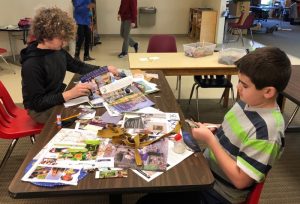 What do you love in the world and think is worth preserving?
What do you love in the world and think is worth preserving?
Upper Elementary students wrestled with this important question during their class project for the Green and White Bash silent auction. My daughter, Stella, is a student in the Upper Elementary classroom, and I was privileged to assist the children in transforming two blank puzzles into a lively mixed media college. Since the Bash’s theme was “sustaining our future” through the funding of student scholarships and staff professional development, I thought it would be fitting for the class project to address this idea of sustainability. So, I asked each student to design a single puzzle piece that identified their own personal junction of love and preservation. All the pieces joined together to form a single, unified collage.
The project turned out to be both intellectually and artistically challenging for the class. Some of the students needed clarification on the question and took extra care to reflect on the conceptual differences among sustainability, preservation, and conservation. Others thought of multiple ideas and found it hard to choose a single focus for their piece. They would sit in thoughtful silence, rifle through magazines for inspiration, or simply run off to do something else, planning to return later. For other children, the process was easier and they settled into their work instantly. Regardless of how quickly their work progressed, it was humbling to witness the moment when each child’s idea clicked into place. You could sense the wave of clarity and purpose wash over them as they set themselves to task. They would sift through the huge pile of assorted collage papers and magazines and dig through buttons, cork, sequins, pom pom balls, threads, beads, and other odds and ends to find the perfect color, texture, or imagery to convey their idea.
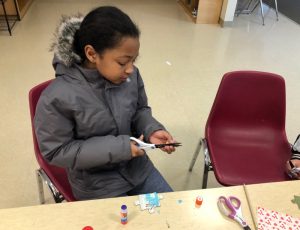 The students’ approaches to composition varied as dramatically as their themes. Some enjoyed working very flat, while others preferred a more 3D composition. Some students chose clipped images and text, while others wanted to incorporate their own drawings. Some designed beautiful miniature scenes of forests and picnics, while others worked more conceptually and built up layers of interest. Each piece was transformed into a unique and carefully crafted work of art.
The students’ approaches to composition varied as dramatically as their themes. Some enjoyed working very flat, while others preferred a more 3D composition. Some students chose clipped images and text, while others wanted to incorporate their own drawings. Some designed beautiful miniature scenes of forests and picnics, while others worked more conceptually and built up layers of interest. Each piece was transformed into a unique and carefully crafted work of art.
After the last student finished, I packed up all of the supplies and took everything home to (literally) put the pieces together. As I assembled the individual pieces into a finished collage, I was amazed by how well the variety of themes and designs worked together. Thirty-seven distinct responses to a single question had morphed into a microcosm of our beautiful, crazy modern world. Elements of nature (birds, oceans, trees) wove through interpretations of social life (family, friends, holidays) and modern living (technology, medicine, Disney). The Upper Elementary class project about sustainability had become an ecosystem of gratitude and hope for the future, where nature merges seamlessly with people, technology, and traditions: very much like a day at Greensboro Montessori School!
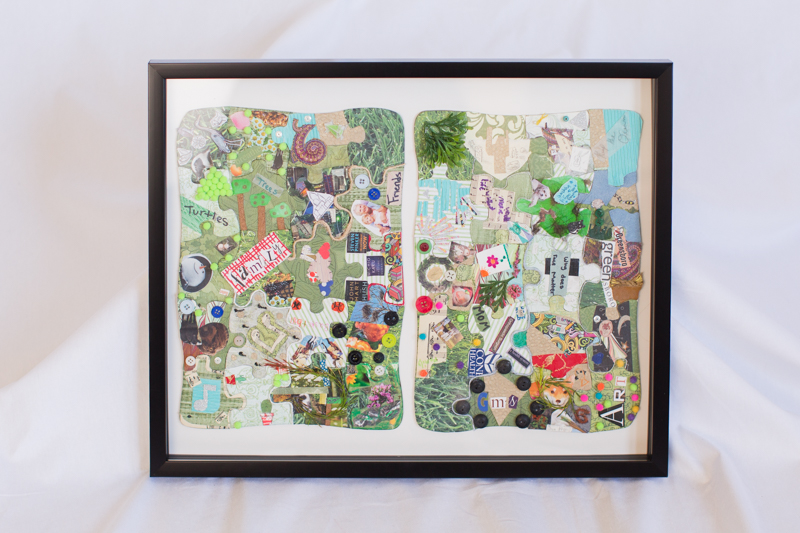
 About the Author
About the Author
Gina Pruette is a parent and regular substitute teacher at Greensboro Montessori School. In addition to her commitment to the School, Gina is an active volunteer within the greater Piedmont Triad community where she leverages her expertise in marketing and events planning, fundraising, and tech solutions to further the missions of various nonprofit organizations. Gina recently completed Racial Equity Training through the Racial Equity Institute to strengthen work with diverse populations, and she holds a bachelor of arts from the University of Pennsylvania.
Greensboro Montessori School's mission is to nurture children to be creative, eager learners as they discover their full potential and become responsible, global citizens.


